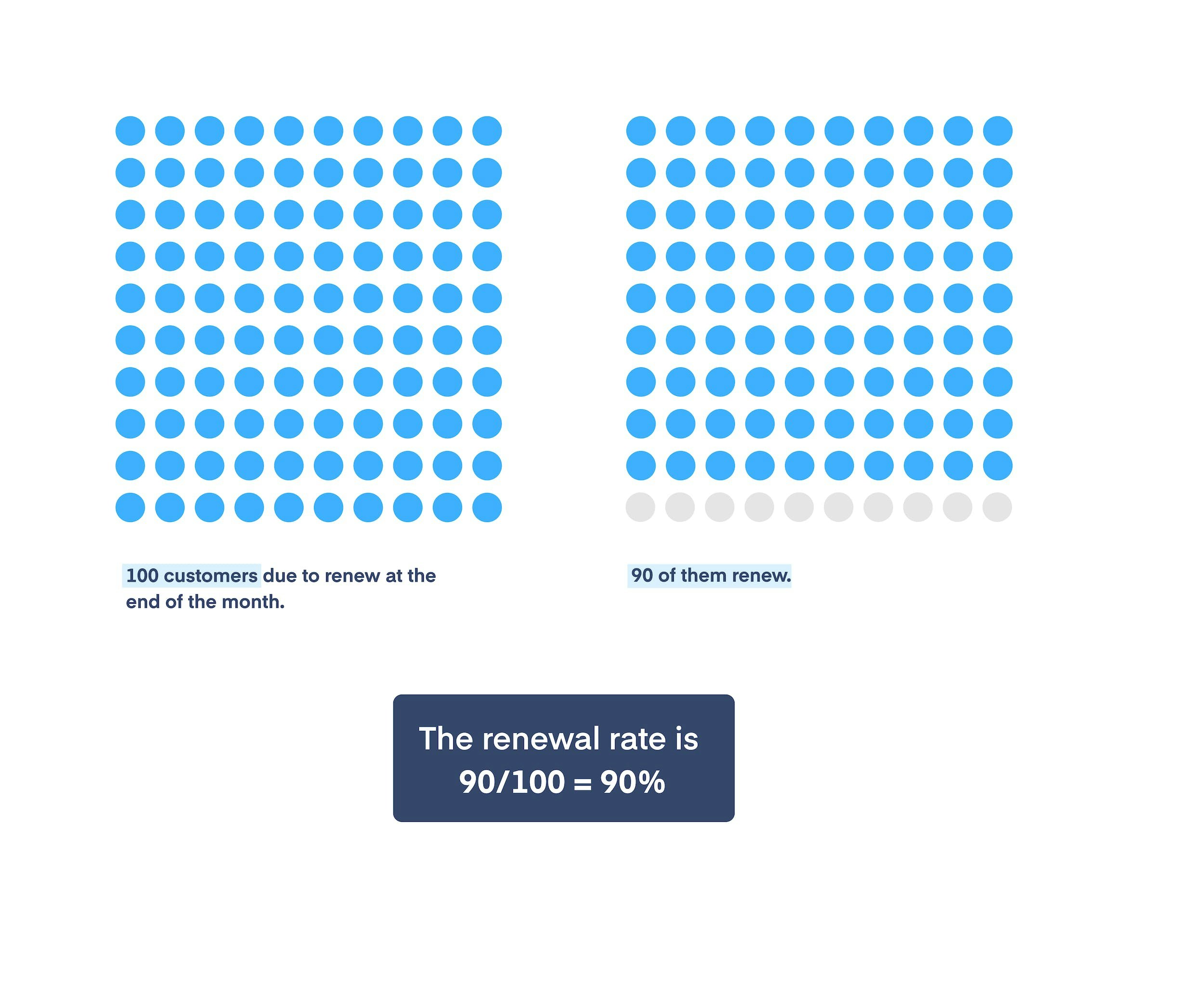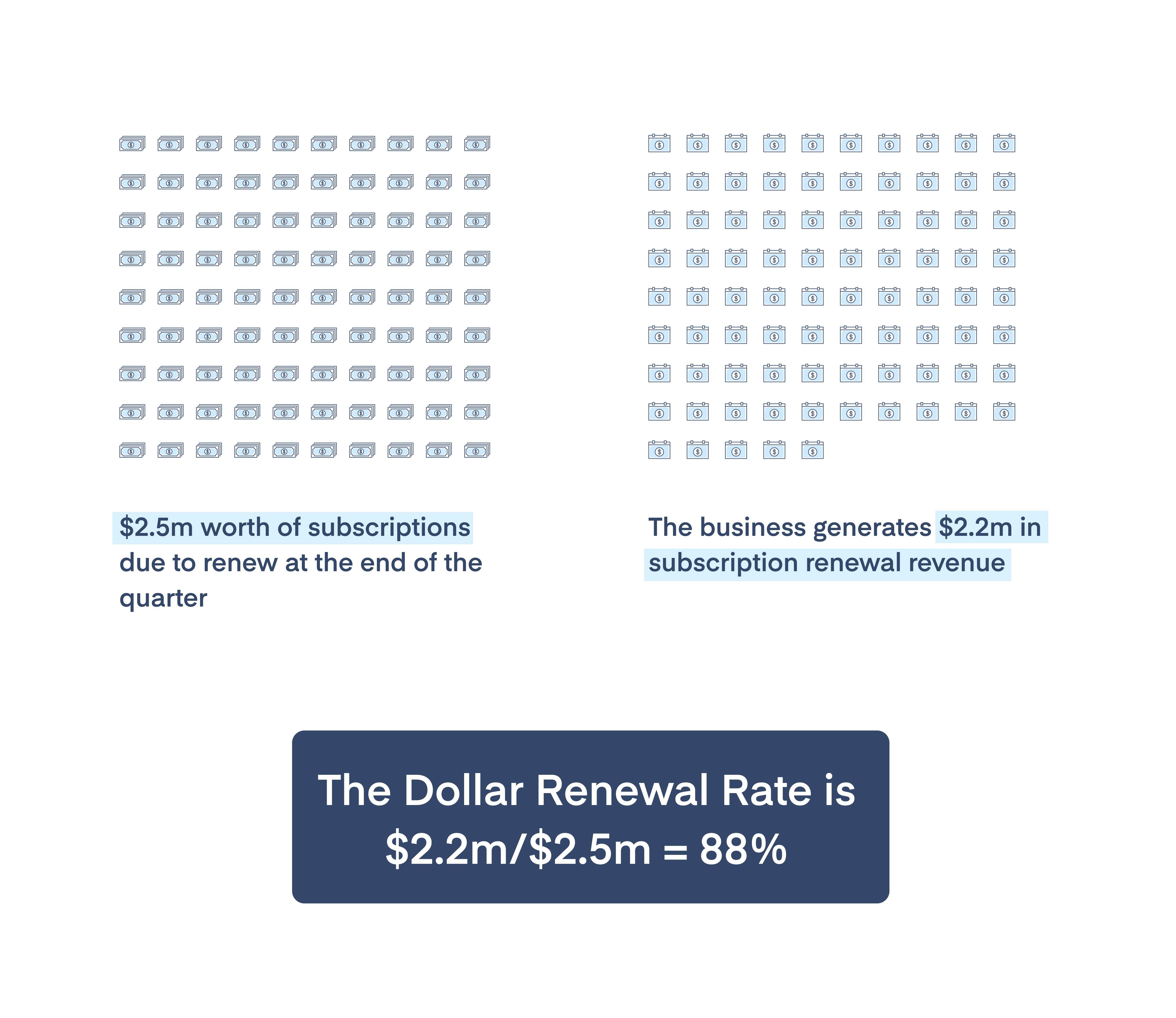The SaaS guide to customer renewal rate
Knowing what percentage of your customers are renewing their subscription is a key indicator of success. Here's everything you need to know to measure and understand your performance.

What is customer renewal rate and why is it important?
Renewal rate is the percentage of your customers that take out a new subscription after their current contract has expired. It is a key SaaS metric, because the longer a customer continues to subscribe, the more profitable they tend to become. This is because acquiring new customers is expensive in the short-term but the longer a customer stays, the more incremental revenue you can get from them.
On the flip side, if a customer fails to renew (known as churn), a business suffers twice; once in the lost revenue, and again in the cost of acquiring a new subscriber to replace them and maintain revenue levels. On average it costs five times more to acquire a new subscriber than the revenue you can expect from a renewal.
Knowing what percentage of your customers are renewing their subscription is a key indicator of success. A high renewal rate points to a healthy SaaS business;when a renewal rate falls, a SaaS business can expect their revenues and profits to head in the same direction.
Why should SaaS businesses care about their renewal rate?
Every SaaS business should track their renewal rate but some will be more interested in it than others. A maturing SaaS business will tend to pivot from targeting hyper-growth to making more revenue from the customers they have. For these businesses, metrics such as Net Retention Revenue (NRR) and Customer Lifetime Value (CLV) become increasingly important, and the basis for these is a healthy renewal rate.
Other businesses have a naturally more transient customer base because of the short-term nature of their product — think dating apps, property search sites and price comparison tools. For them, new customer acquisition will be more of a focus than renewal.
The difference between renewal rate and retention rate
There is a subtle difference between renewal and retention rates. ‘Renewal’ refers to a specific moment in time, where a subscriber makes an active decision to continue with their subscription. In this scenario, if the customer does nothing, their subscription expires. With ‘retention’ the emphasis is on the ongoing management of a customer to stop them from actively canceling, at any time.
SaaS companies should approach retention and renewal as complementary strategies. Get retention right, and subscription renewal should follow. But some employ retention tactics specifically at the point of renewal. In other words, if the customer does nothing, their subscription automatically carries on.
Intuitively this seems sensible. You may wonder why any SaaS businesses would make a customer actively resubscribe, and risk them not doing so. Part of the answer is regulation; some services have a legal requirement for the subscriber to actively opt-in for another term and some markets have additional verification requirements on subscription payments (as is the case in India). Sometimes it’s about ensuring a subscriber’s payment details are up to date. It can be better to do that upfront, instead of trying to take a payment with an old card or bank details and then having to go back to the customer anyway. But there is also the question of customer intent. A subscriber that takes time to actively renew is communicating loyalty, whereas a customer you retain may be more passive, and so more vulnerable to cancellation at a later date.
Different renewal rates and how to calculate them
The easiest way for SaaS businesses to calculate a renewal rate is to divide the number of customers that did renew by the number of customers that could renew. And depending on the term of a subscription period, it may be more appropriate to calculate renewal rates at monthly, quarterly or even annual intervals.

If a SaaS business is offering multi-seat subscriptions (common in the B2B market) then you’ll also want to dig down to the user level.

Dollar renewal rate
Looking just at customer numbers doesn’t provide the full picture. For that, you also need to calculate renewal rates in monetary terms. We call this ‘dollar renewal rate’.

It’s worth noting that your dollar renewal rate can go up, while actual customer and user numbers go down, if renewing customers are paying higher subscription fees than last time.
Net MRR renewal rate
SaaS businesses can take dollar renewal rate a step further by looking at net MRR renewal rate. This also takes into account the value of any expansion or contraction of services by a subscriber.

The calculation then follows:
- Potential Dollar Renewal Rate is 33 customer * $100 = $3,300
- Actual Dollar Renewal Rate is: (20 customers * $100 = $2000) + (4 customers * $110 = $440) + (2 customers * $80 = $160) = $2,600
- Net MRR Renewal Rate is $2,600 / $3,300 = 79%
Net MRR renewal rate can be in excess of 100%, which is a sign that subscribers are not only renewing in good numbers but buying more too.
Renewal segmentation
As well as calculating overall renewal rates by customer numbers and revenue, SaaS businesses should also perform segmentation analysis, to understand fluctuations at a customer, product, channel and geography level.
Segmentation at a granular level exposes where renewals are much higher, or much lower, than the company average. This offers valuable insights, which you can apply to the rest of your business. For example, a low renewal rate in a particular country may suggest that the product needs to be tailored better to that audience. Equally a high renewal rate at a specific subscription tier may prompt you to move other customers into this bracket.
Five ways to improve your renewal rate
1. Understand your segments
Different parts of your business perform better than others. Understanding where things are going right is the first step in analyzing the reasons and how to replicate them elsewhere. To do that you’ll need a sophisticated subscription management tool, which allows you to segment your subscribers by multiple parameters.
2. Invest in your product
Having an ambitious product roadmap, and the resources to execute it is vital to subscription renewal. Better still is to ask subscribers what they want to see. You may not be able to always deliver their wishes, but the engagement alone will be valued. It’s also important to take a holistic view of your product. Present it simply as the software features, and that’s how subscribers will judge it too. But add in customer support, advisory services, and community events, and you give subscribers more reasons to stick with you.
3. Find the early warning signs
If a subscriber is likely to churn, it’s better to know about it as early as possible, to give you enough time to persuade them otherwise. Clues pointing to vulnerable customers can be found everywhere. Low engagement with the product is an obvious red flag. A look at which customers have been raising support tickets may also suggest those with frustrations. Low satisfaction scores offer a more direct hint… including those that fail to submit a survey. And scanning trade press, social media and business networks for negative feedback, or news of RFPs can also reveal subscribers in need of extra attention.
4. Make renewing easy
Compared with a new sale, a subscription renewal should be admin light. You already have the customer’s personal details, subscription package and payment information — so don’t ask for these again. And don’t be caught out by an expired card. This is relatively easy for a vendor to mitigate against because they know when the card will expire and so should prompt the subscriber to update their details before the renewal payment is due. This tactic is not possible with lost and stolen cards; but timeliness in letting the customer know their card was rejected, and directing them to update their new card details, still makes a big difference.
Offering a wider range of payment methods at renewal time could allay any lingering doubts. Payment methods with a direct source of funds, like PayPal, don’t expire and are less likely to fail.
5. Deflect and recover
Not every subscriber is going to renew immediately, but that doesn’t mean they won’t in the end. So keep communicating with them. Understand why they haven’t renewed, and take the appropriate action. You can also give customers the option to pause their subscriptions, rather than cancel. Here's our Senior Product Manager, Rebecca on why giving people alternatives to cancelling is important.
If they’re concerned about the price, is there an incentive you can offer? If they’re planning to switch to a competitor, what can you tell them about your relative strengths and their relative weaknesses? Perhaps the decision-maker is new, and some onboarding training might buy you time.
The key is to tailor your approach as much as possible. But if you’re an enterprise, faced with hundreds of renewals at any one time, this is easier said than done. Automation is the answer; using what you already know about a customer, and their responses, to guide them to the most persuasive content.